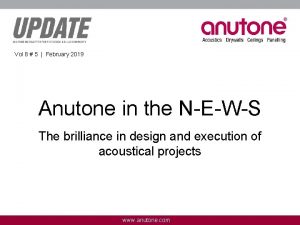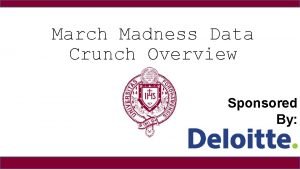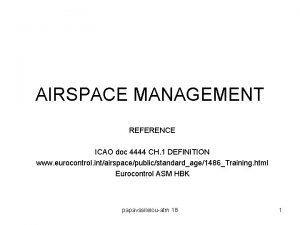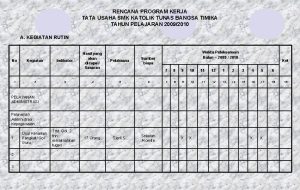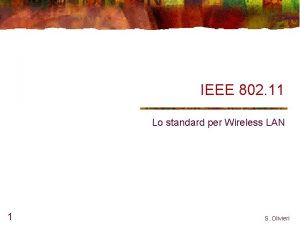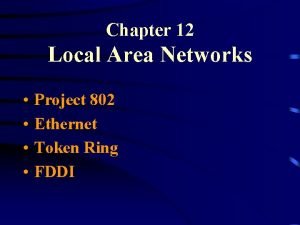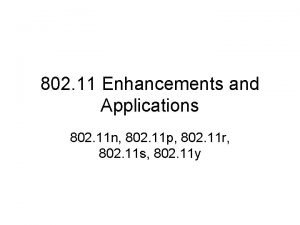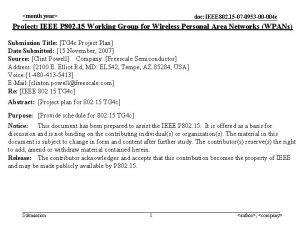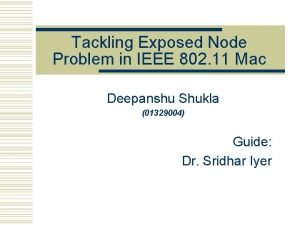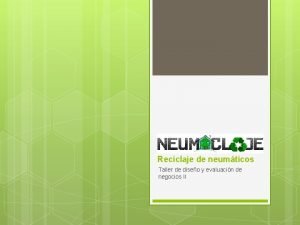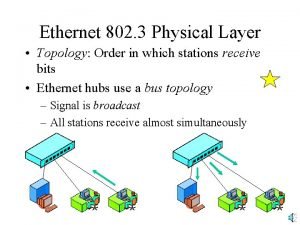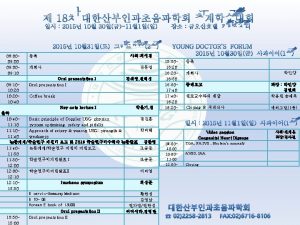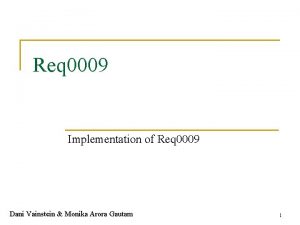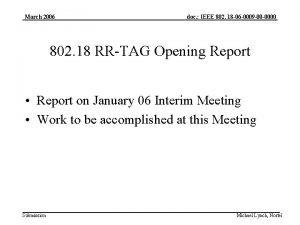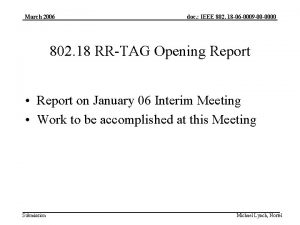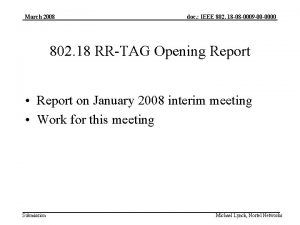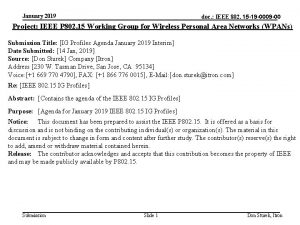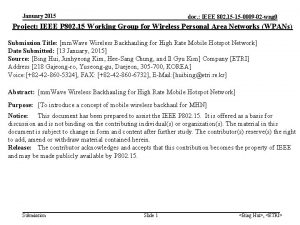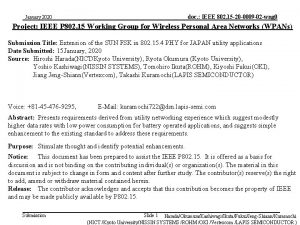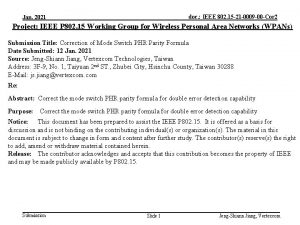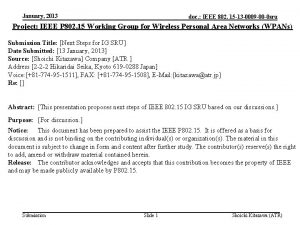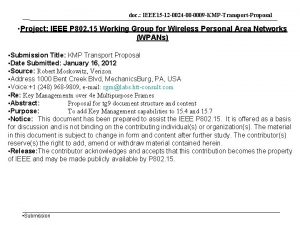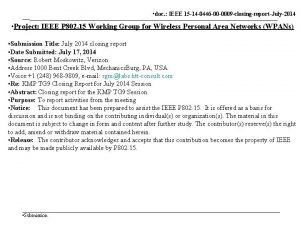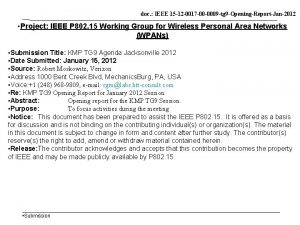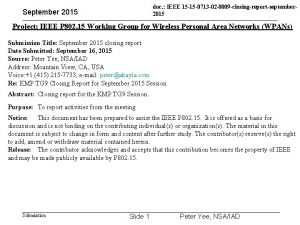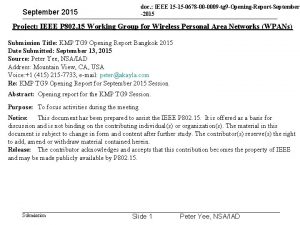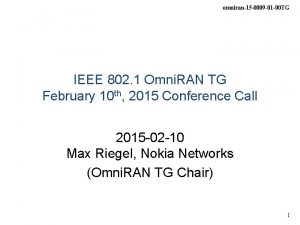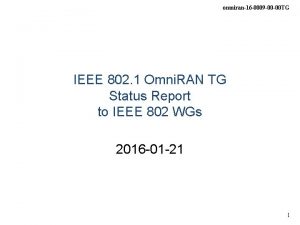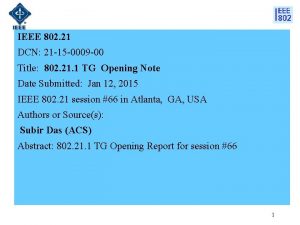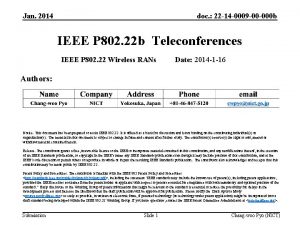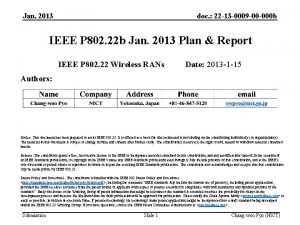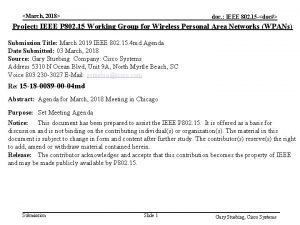March 2019 doc IEEE 802 24 19 0009
























- Slides: 24

March 2019 doc. : IEEE 802. 24 -19 -0009 r 0 802. 24 Vertical Applications TAG Closing Report March 2019 Vancouver, BC, Canada Submission Slide 1 Tim Godfrey, EPRI

March 2019 doc. : IEEE 802. 24 -19 -0009 r 0 802. 24 Overview • Officers – TAG Chair: – Secretary & TAG Vice Chair: Tim Godfrey Ben Rolfe • Task Groups – 802. 24. 1 Smart Grid TG – 802. 24. 2 Io. T TG Tim Godfrey Chris Di. Minico • 26 Voting Members • Agenda: 24 -19 -0007 -00 • Meetings for the Week – Monday PM 2 – Tuesday PM 2 – Wednesday PM 2 24. 1 24. 2 24. 1 • Manual attendance tracking for 802. 1 & 802. 3 members Submission Slide 2

March 2019 Agenda – 802. 24 -19 -0007 r 1 802. 24 Agenda - March 2019, Vancouver, BC, Canada 24 -19 -0007 -01 -0000 1 1. 2 1. 3 1. 4 1. 5 1. 6 1. 7 Monday PM 2 session Call session to order, present “Guidelines for IEEE SA meetings”, Quorum Review of Agenda / Approval of Agenda Approve minutes from prior TAG meeting Introduction/meeting objectives / Review action items from previous meeting Liaison Review 802. 24. 1 Smart Grid Task Group Liasion Discussion of IEC SEG 8 report "Monitoring and impact assessment of emerging technologies and architectures" 1. 8 1. 9 2 2 2. 1 2. 2 2. 3 2. 4 2. 5 Godfrey Godfrey 5 5 15 0 4: 00 PM 4: 05 PM 4: 10 PM 4: 15 PM 4: 20 PM 4: 35 PM Collaboration with 802. 21: 'Network Enablers for Seamless HMD-based VR (Virtual Reality)’ Review any comments and finalize TSN White Paper Recess Godfrey / Das Godfrey 15 30 20 0 4: 35 PM 4: 50 PM 5: 20 PM 5: 40 PM Tuesday PM 2 session Call to Order 802. 24 TAG Progressing "Network Integration" concept into a project Call to Order 802. 24. 2 Io. T Task Group 802. 24. 2 Liaison Coordinator's Report Godfrey Di. Minico 0 30 0 15 4: 00 PM 4: 30 PM 5: 00 PM Di. Minico/Godfrey Di. Minico Godfrey 15 15 0 5: 15 PM 5: 30 PM 5: 45 PM Godfrey/Farkas 30 6: 00 PM 0 4: 00 PM 15 4: 15 PM 2. 6 2. 7 2. 8 Review of Io. T white paper development, expanding scope and participation Single Pair Ethernet White Paper Recess Joint Meeting with 802. 1 TSN 3 3. 1 3. 2 Call to Order 802. 24 TAG ITU and regulatory items 3. 3 doc. : IEEE 802. 24 -19 -0009 r 0 Wednesday PM 2 session Liaison with ATIS TOPS Council Io. T Categorization Focus Group - review and comment on Io. T Characteristics Matrix 3. 4 Low Latency White Paper 3. 5 Coordination with 802. 19 on 802. 15. 4 g and 802. 11 ah Coexistence project 3. 6 Submission Slide 3 802. 24 New Action Items, New Activities, AOB 3. 7 Adjourn Godfrey/Holcomb Godfrey Holland Godfrey/Rolfe Godfrey 40 4: 55 PM 30 5: 25 PM 15 5: 40 PM Tim 10 Godfrey, EPRI 5: 50 PM 0 5: 50 PM

March 2019 doc. : IEEE 802. 24 -19 -0009 r 0 802. 24 TAG • Approve January minutes – 24 -19 -0005 r 0 • TAG Action Items from January: ü Announce Io. T Matrix teleconference on reflector, with call for comments (done) ü Re-announce TSN white paper call for comments for March meeting (Done) Submission Slide 4 Tim Godfrey, EPRI

March 2019 doc. : IEEE 802. 24 -19 -0009 r 0 Monday 802. 24. 1 Smart Grid TG Submission Slide 5 Tim Godfrey, EPRI

March 2019 doc. : IEEE 802. 24 -19 -0009 r 0 Goals for AR/VR collaboration in 802. 24 • 802. 21 plans to provide the services layer above the MAC/PHY – AR/VR is an identified vertical application for Smart Grid (electric utilities) for field force, safety, and training • 802. 24 will liaise to other WGs if they develop amendments to their standards to support RTC. – 802. 21 will provide input on requirements to WGs – Vertical Application areas can provide input on specific use cases – Include representatives from related activities in other WG’s • 802. 24 will provide a venue for collaboration (joint meetings) at Plenary Submission Slide 6 Tim Godfrey, EPRI

March 2019 doc. : IEEE 802. 24 -19 -0009 r 0 Next Steps • • 802. 21 to provide text contributions Goal is to have the real time white paper by 2020? Bring together various working groups to solve issues for VR and performance. Application space is driven by ever increasing resolution. Target HDMI 1. 2 specification. Resolultion and frame rate drive data rate. Can it be compressed? • This can be seen as alternative to 5 G approaches, but standards-based and lower cost to use. – Show Wi-Fi technology can provide an equally good or better result and performance (bandwidth and low jitter and low latency) • Map identified uses cases on to various IEEE 802 standards. Submission Slide 7 Tim Godfrey, EPRI

March 2019 doc. : IEEE 802. 24 -19 -0009 r 0 Liaison with IEC SEG 8 • Scope of SEG 8: – – • Document shared in 802. 24 Private Area – – • Assess, provide an overview and prioritization of the evolution of technical development and standardization in the field of communication technologies and architectures The report includes aspects relevant to both Smart Grid and Io. T. IEC_SEG 8_Deliverable 2_draft_181118_ext_clean. pdf Updated version uploaded to private area with annotations Key chapters relevant to input from 802. 24 – – – Io. T Technologies Single-pair Ethernet (SPE) Deterministic Networking Low-Power Wide-Area Networks (LPWAN) V 2 V, V 2 I, V 2 P and V 2 N communication technologies • Final Opportunity to review and comment as SEG 8 is finishing in next few months • Comments captured. Draft with comments uploaded to private area. Submission Slide 8 Tim Godfrey, EPRI

March 2019 doc. : IEEE 802. 24 -19 -0009 r 0 TSN White Paper • Remaining embedded comments resolved • Final review with 802. 1 TSN – Updated status of several TSN standards – Update posted as 24 -18 -0022 r 3. • Remaining comment for input from 802. 21 on VR enablers in utility use cases Submission Slide 9 Tim Godfrey, EPRI

March 2019 doc. : IEEE 802. 24 -19 -0009 r 0 Tuesday 802. 24 TAG Submission Slide 10 Tim Godfrey, EPRI

March 2019 doc. : IEEE 802. 24 -19 -0009 r 0 “Network Integration” action item • Action assigned from 802 EC leadership conference in July. – Discussion on role and positioning of IEEE 802 in standards, especially with respect to 3 GPP and the publicity on “ 5 G” • What is meant by Network Integration? – Does the IEEE 802 architecture provide a unique value to vertical market? – Is IEEE 802 more suited to deployment in the communication infrastructure of private enterprise, industry, and the individual user? (Compared to 3 GPP, which is more oriented towards service providers? ) – The IEEE 802 architecture enables networks that are like Ethernet: Well understood, mature, predictable. A “cleaner” integration of disparate technologies under the common architecture and addressing. • Can we develop a clearer definition and description of this distinction and the value for the user / implementer? • Can this be developed into a white paper? Submission Slide 11 Tim Godfrey, EPRI

March 2019 doc. : IEEE 802. 24 -19 -0009 r 0 Review of 802. 1 CF in this context • November Presentation – Max Riegel “Thoughts on IEEE 802 network integration with respect to P 802. 1 CF” 24 -18 -0026 r 0 • Discussion – Based on many discussions of the place of 802. 11 in 5 G. – 5 G SC • Conclusions – AANI integrating 802. 11 into 5 G domain. Nothing corresponding in 3 GPP • Industry connections – NENDICA – Flexible Factory Io. T, Data Center Bridging – What’s missing – a picture of 802 as a peer to 5 G – 5 G promises they will do “everything” • But, they don’t do anything wired – 5 G requires an extensive PLMN to support it. • It is designed to help the cellular operator grow their market – Verticals might not want an operator in the middle of their network – Value proposition: 802 networks are customer-owned • Example – Santa Clara Emergency services issues Submission Slide 12 Tim Godfrey, EPRI

March 2019 doc. : IEEE 802. 24 -19 -0009 r 0 Key Points from Discussion • • • IEEE 802 is a transport network IEEE 802 is Layer 2 3 GPP RAN is layer 3 only, Layer 2 is not available Direct support of IPv 4 and IPv 6 or pure layer 2 protocols Trade-off between flexibility (L 2) and scalability (L 3) – – – Routing provides path to higher scale Smaller scale provide more flexibility Smaller scale provides opportunity for real-time IEEE 802 can route via L 3 when needed. 3 GPP cannot offer L 2 IEEE 802 can also offer L 2 routing when appropriate (e. g. 802. 15. 10) • Not an alternative to L 3 routing, but there to address a different problem Submission Slide 13 Tim Godfrey, EPRI

March 2019 doc. : IEEE 802. 24 -19 -0009 r 0 Key Points, contd • 802 does not provide as many means control a specific end device and it’s traffic on a path. – There are some management facilities in some standards • 3 GPP networks provide more tools for subscriber management • 802 provides local networks that may be (but don’t have to be) connected into an Internet. • Operator networks are focused on services for single devices, while 802 networks support and include multiple devices (networks of networks) – devices can communicate with each other as well as with other networks Submission Slide 14 Tim Godfrey, EPRI

March 2019 doc. : IEEE 802. 24 -19 -0009 r 0 Non-802 wireless Io. T networks • Commercial, proprietary Io. T services – They don’t have an ethernet like L 2. The system does not have the concept of a LAN. It is terminal to central “gateway” only. Star topology only. – Similar to LTE UE to UE traffic that must route through core. (DTD Proximity services have addressed that to some extent) • 5 G URLLC, and MMTC. – IEEE 802 has already developed TSN in wired, and now being developed for wireless. – Latency is impossible to guarantee in unlicensed, shared spectrum. However it can be highly optimized by the MAC layer. – IEEE 802 has a history and internal coordination of coexistence between different standards operating in unlicensed spectrum. 3 GPP is oriented towards exclusively licensed spectrum, “sharing” is a foreign concept. • 3 GPP has a common strategy for the three use cases. IEEE 802 has a common architecture, but not a common business strategy. – License exempt can provide higher economic value per MHz of spectrum. – See WFA economic value. Cisco Visual Networking Index. Wi-Fi carries more data than all cellular spectrum – Wi-Fi created the expectation of broadband wireless that led to the development of LTE • What would it look like to combine multiple IEEE 802 standards into a single offering? – Some vendors already do that – integrating 802 technologies into systems. – The “Package” offered by the “ 5 G” ecosystem is clearly articulated. – What is the comparable offering from IEEE 802? Submission Slide 15 Tim Godfrey, EPRI

March 2019 doc. : IEEE 802. 24 -19 -0009 r 0 Key Points, contd. • IEEE needs to think about how to create that package without a “subscription model” – IEEE 802 is often free • • IEEE 802 is deployed in vertical markets, where the network is owned and operated by the user of the services. Are there other models for IEEE 802 other than subscription that can provide ancillary economic value? – Is management of shared spectrum a candidate? • IEEE 802 and unlicensed spectrum enables faster innovation – Many of the breakthrough innovations were not as planned • • The story of why IEEE 802 complements everything else, and everything else (alone) is not sufficient. Io. T is built around many specialized niches. The challenge is meeting the diverse requirements. IEEE 802 provides multiple standards to address multiple Io. T applications. Submission Slide 16 Tim Godfrey, EPRI

March 2019 doc. : IEEE 802. 24 -19 -0009 r 0 Next Steps • Do we pursue a white paper in this area? • Yes, there is a good reason, and a starting point • Volunteers to assemble notes into a draft white paper • Discuss at next meeting of TAG - May in Atlanta, and also in July in Vienna Submission Slide 17 Tim Godfrey, EPRI

March 2019 doc. : IEEE 802. 24 -19 -0009 r 0 Wednesday 802. 24 TAG Submission Slide 18 Tim Godfrey, EPRI

March 2019 doc. : IEEE 802. 24 -19 -0009 r 0 ITU and Radio Regulatory Items • Update from 802. 18 – Jay Holcomb • 900 MHz licensed spectrum NPRM – Will be discussed at Open Meeting of FCC – Call 900 MHz Broadband, but is not related to ISM band. – 896 -901 and 935 -940 MHz. Propose to transition part of band from channelized LMR to 3 x 3 MHz. Move LMR into remaining portion of band. – Up to 400 W/MHz PSD ESD on towers 304 m. (similar to narrowband paging at 1 KW) – Is there a possible interference concern with ISM systems in 902 -928 MHz? • OFCOM – 2390 -2400 MHz consultation – High power devices could interfere with lower end of 2. 4 GHz ISM band – This is planned as licensed spectrum – 802. 18 will consider a late filing Submission Slide 19 Tim Godfrey, EPRI

March 2019 doc. : IEEE 802. 24 -19 -0009 r 0 Liaison with ATIS TOPS Council Io. T Categorization Focus Group • ATIS: Alliance for Telecommunications Industry Solutions • Review and comment on Io. T Characteristics Matrix provided by ATIS • Review completed and matrix with comments posted as 24 -19 -0004 r 4 • Will be forwarded back to ATIS committee Submission Slide 20 Tim Godfrey, EPRI

March 2019 doc. : IEEE 802. 24 -19 -0009 r 0 “Low latency” White Paper • Achieving low latency with IEEE 802 standards – Including wired and wireless communications – An alternative (or complement) to 5 G URLLC • A set of vertical applications enabled by low latency • The challenges of reliable low latency in unlicensed spectrum. – Adapting TSN’s “FRER” feature – Adapting 802 wireless to licensed spectrum? – Operating over multiple bands or channels? • Special cases for high data rates for immersive video • Oliver Holland is leading white paper development • Outline draft discussed, edited, and updated as 24 -19 -0003 r 1 Submission Slide 21 Tim Godfrey, EPRI

March 2019 doc. : IEEE 802. 24 -19 -0009 r 0 802. 15. 4 g and 802. 11 ah Coexistence (802. 19. 3) • 802. 24 will develop a whitepaper/document for application-specific use cases. Identifying where each standard is most suitable, and how to make best use of other changes. • • Identify use cases where 802. 15. 4 g is not sufficient and both are needed Could be choices of applications, channel guidelines, duty cycle, Avoid perception that 802 standards are unable to coexist Evaluate and describe potential application-level implications of delay/latency increases due to mutual interference • 802. 19. 3 project schedule: – A draft ready by April – WG Ballot Sept 2019 – SA Ballot November 2019 • Consider starting a white paper in 2 nd half of year. Review in July Submission Slide 22 Tim Godfrey, EPRI

March 2019 doc. : IEEE 802. 24 -19 -0009 r 0 2019 TAG Activity Plan • “Low latency” White Paper – Continue in May – Include 802. 21 AR/VR activity – Nendica FFIOT might also fit into this • “Network Integration” white paper about unique benefits of IEEE 802 architecture – Develop notes from discussion this week into outline for white paper • A whitepaper/document for application-specific use cases of Sub 1 GHz standards 802. 15. 4 g and 802. 11 ah. Identifying where each standard is most suitable, and how to make best use of mechanisms proposed in 802. 19. 3 TG. – Can this also include applying 802. 15. 4 s in sub-1 GHz spectrum? – 2 H 2019 for starting • TBD – 802. 24 white paper on Io. T and P 2413 – Update of first Smart Grid white paper to address latest amendments of 802. 15. 4 u, v, w, x, y, Revmd Submission Slide 23 Tim Godfrey, EPRI

March 2019 doc. : IEEE 802. 24 -19 -0009 r 0 802. 24 TAG closing • Action Items from this meeting – Get latest P 2413 draft for private area – Subir Das to provide VR text for TSN White Paper • Any New Business? Submission Slide 24 Tim Godfrey, EPRI
 Bridges from 802.x to 802.y
Bridges from 802.x to 802.y Bridges from 802.x to 802.y
Bridges from 802.x to 802.y Anthem of poland
Anthem of poland Ieee 802 bluetooth
Ieee 802 bluetooth 802 ieee
802 ieee Ieee 802
Ieee 802 Ieee 802 family
Ieee 802 family Ieee 802 3 compliance
Ieee 802 3 compliance Wlan standards
Wlan standards Arquitetura ieee 802
Arquitetura ieee 802 802 ieee
802 ieee Ieee 802 standard
Ieee 802 standard Grihalakshmi magazine march 2019
Grihalakshmi magazine march 2019 Kaggle march madness 2019
Kaggle march madness 2019 Icao document 4444
Icao document 4444 Program kerja tata usaha smk
Program kerja tata usaha smk 802/11
802/11 Ssin-802
Ssin-802 Project 802
Project 802 802 11 n
802 11 n 802-11-iapp
802-11-iapp 802 15
802 15 Exposed node problem
Exposed node problem 507-802-380
507-802-380 802 3
802 3












